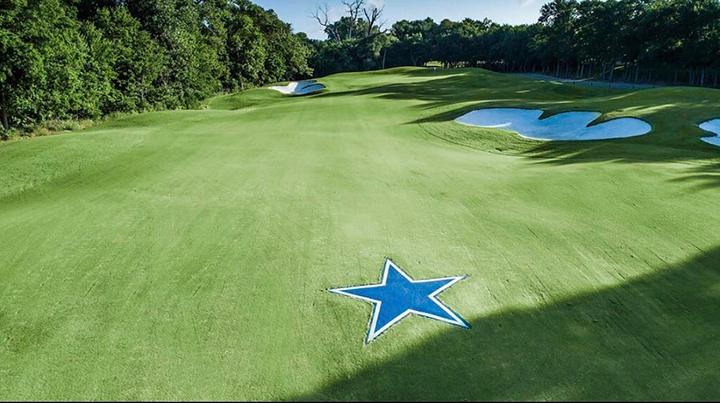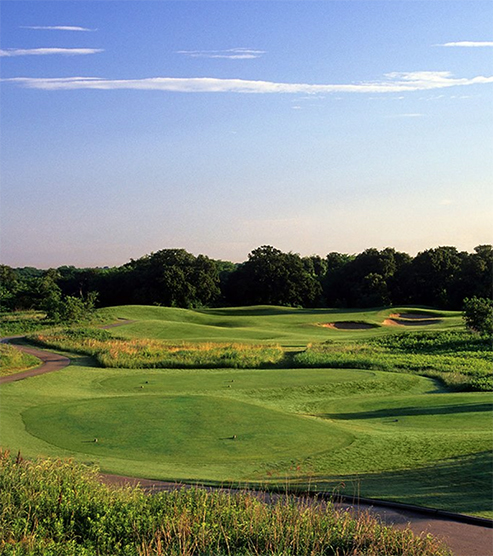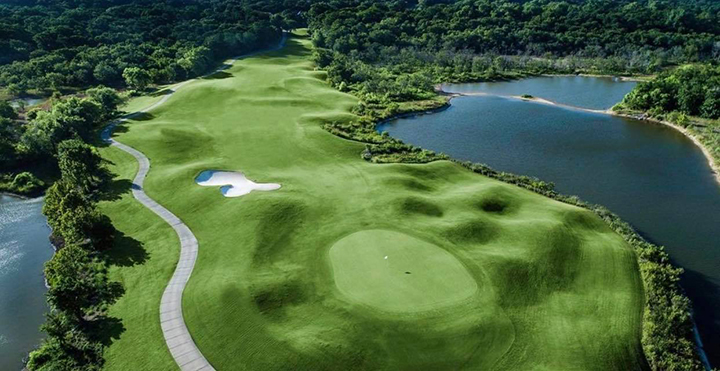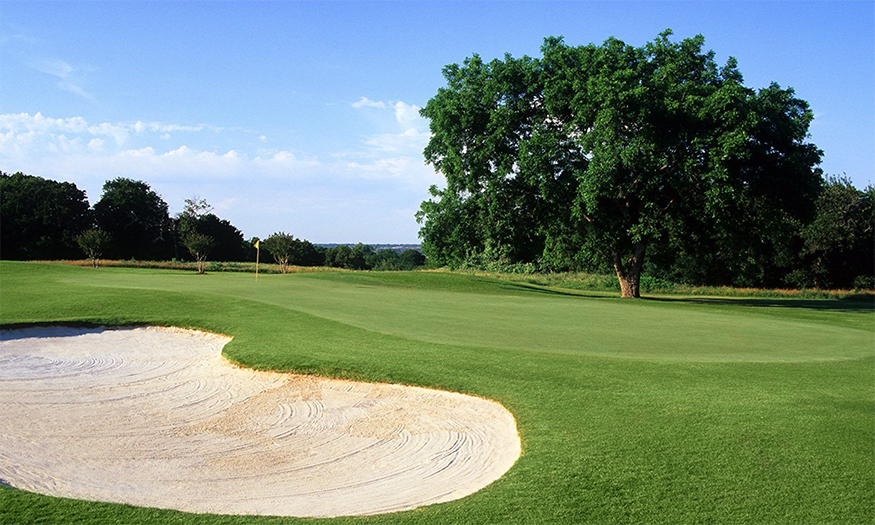
Dallas – “Big D,” as most Texas call it – is a hotbed for great golf courses that have spawned a roster of Hall of Fame golfers such as Lee Trevino and Lee Elder and currently prominent PGA Tour young guns Masters champion Scottie Scheffler, five-time Major winner Jordan Spieth and the enigmatic Will Zalatoris.
If you’ve ever been to Dallas, you know it’s built on flash – an expansive city of bright lights and glitz on the prairie of north Texas where everything is big. To stand out in this region, you have to bring something unique to the table, and some of the neighboring suburbs go out of their way to garner golfers’ attention and then go the extra mile to keep it.
Such is the case of the four courses we will profile here – the Cowboys Golf Club in Grapevine, Texas Rangers Golf Club in Arlington, and the Tribute and Old American Golf Clubs in the Colony.
Each of these facilities are beloved by their regular players for their quality as much as they are for their uniqueness, and we highly recommend a round at all four if you are up for a trip to Dallas and its nearby communities.

Texas Rangers Golf Club
Cowboys Golf Club is the template
Back at the end of the 20th century, Dallas Cowboys owner Jerry Jones came up with a notion to open a golf course that was as over-the-top and opulent as his football team.
Jones’ son Stephen ran with the idea, acquired a 160-acre parcel of land just north of the hulking Dallas-Fort Worth Airport, and hired noted golf architect Jeffrey Brauer to fashion what would become Cowboys Golf Club.
In the more than 20 years since Cowboys Golf Club opened, it’s remained a staple on the best-of lists in the Dallas area, not only for its novelty but for the quality and conditioning of the course itself.
Cowboys Golf Club remains the only NFL-themed golf club in the world. Brauer’s routing is scenic as well as a fun and challenging 18 holes. He worked closely with the City of Grapevine and the Army Corps of Engineers to preserve the natural environment while creating a unique Dallas-area golf experience.
Cowboys Golf Club throws a lot at the golfer and tests his or her game from the tee box to the cup. There are stands of trees, ponds, creeks and natural habitats, dramatic elevation changes, plenty of forced carries, doglegs, large bunkers, contoured fairways, and complex putting surfaces.
While challenging for scratch golfers, four sets of tees on each hole enable golfers of all ages and abilities to enjoy this unique golf gem.
Cowboys Golf Club begins and ends with par-5s, which can be a great way to start and finish the round. The signature hole at the course is the par-4 fourth hole. It’s one of the most drastic downhill two-shotters in the area and also provides a great photo opportunity, as there is a giant Cowboys logo blue star painted in the middle of the fairway.
Players will find two of the most difficult par-4s on the front nine at Cowboys – the fifth (No. 1 handicap) and the seventh (No. 3). No. 5 is a difficult driving hole as there is blind water hidden on the left. A nearly blind long-iron approach is required to reach the demanding green. The seventh is a lengthy dogleg right with OB right and a smattering of small trees and underbrush left. A good tee shot still leaves a mid-iron approach.
The facility is a tribute to the five-time world champion NFL team and integrates a historical tour of the franchise’s accomplishments throughout the round. The clubhouse features a Hall of Honor with a magnificent display of the team’s Super Bowl trophies and memorabilia of Cowboys legends both past and present.
Historical markers along the golf course provide a unique insight into the illustrious plays and prominent players who created an era of mystique that continues to fascinate sports fans worldwide.
Part of the draw to playing Cowboys Golf Club is that it’s an all-inclusive package. That means all meals, snacks, and non-alcoholic beverages during your entire time at the course are included at no extra charge.

Texas Rangers Golf Club follows the pattern, on a smaller scale
It’s been said that imitation is the sincerest form of flattery, so the City of Arlington can expect a nice pat on the back for its work in opening Texas Rangers Golf Club, just a few miles north of both AT&T Stadium, the home of the Cowboys, and Globe Life Field, the three-year-old stadium for the Rangers of the American League.
Born from the complete $24 million reworking of the former Chester W. Ditto municipal course owned by the city and golf architect John Colligan, Texas Rangers Golf Club has been rebranded and is the first and only Major League Baseball-themed course in the country.
One of the primary reasons for rerouting the course was to take advantage of the 55 feet of elevation change on the site. The first tee sits some 45 feet above the lowest spot on the fairway. Colligan’s fairways are broad and playable, and the putting surfaces are large and golfer friendly. The overall scale of the course is “Texas Big,” with more than 111,000-square feet of sand bunkers defining the routing.
Texas Rangers Golf Club stretches to 7,010 yards for low-handicap golfers and has hosted a Korn Ferry Tour event. The course features four sets of tees to ensure a great playing experience for golfers of all ability levels.
The opener here is a par-5 on which players try to sling a high draw over the corner of the driving range to a mid-iron distance. A dramatically undulating putting surface awaits, but a shot that finds the proper spot on the green can lead to a reasonable eagle chance.
One of the best stretches of golf at Texas Rangers Golf Club are holes four, five and six. The opening par-4 of this three-hole stretch features water on the left that is blind from the tee box. A tee shot that finds the fairway will leave nothing more than a wedge to the green but any ball that strays left of the fairway bunkers will end up finding a watery grave.
The par-4 fifth offers up an elevated tee box and a split fairway. Players who choose the more aggressive left line over the lake will be rewarded with a shorter shot, while those opting for the right will be presented with a more awkward angle and a longer approach.
The 135-yard, par-3 sixth hole may well be the most talked about hole on the new routing. It sports the largest sand bunker on the course and the largest green, measuring 180 feet from the front to the back, with a huge hump in the middle, making accuracy off the tee paramount.
The round here ends with a 532-yard par-5. There is 25 feet of elevation change from the back tee down to the landing area and another 25 feet from the landing area up to the green. A speed-slot just over the fairway bunker will rocket balls forward, leaving a short approach that can lead to a potential eagle or birdie in the shadow of the clubhouse.
The massive clubhouse is located upon the promontory of the property with great vistas to the northeast overlooking the course and out across the area and is finer than fine. The “Home Plate” bar is as nice as any sports bar you will ever step foot into, with 31 televisions scattered around including a back wall there is another set of eight TVs that can be programmed to show one specific event in large format, or the individual screens can show multiple channels.
In addition, there’s a great golf shop with not only everything you would need to prep for your round but some great Texas Rangers gear as well.
Because the Rangers don’t have the history of success enjoyed by the Cowboys, there is not the “in-your-face” reminder of the area’s MLB team around every turn. But the holes are named after baseball terms – like “Pop Up” and “Power Alley” and “Gap Hitter” and Squeeze Play” – and there is an on-deck circle near the first tee to stretch out in before the round.

Davis hits the spot at Old American & Tribute courses
If you long to play golf in Scotland or even to tee it up on some of America’s great courses designed by legendary architects, you can do that and more by driving less than an hour from downtown Dallas.
The Tribute Golf Club, with holes patterned after the celebrated courses of Scotland and the British Open, and the brand-spanking-new Old American Golf Club, which focuses on emulating design techniques from significant American courses at the turn of the 20th Century, are the centerpieces of a 1,150-acre master-planned community in the northern Dallas suburb of The Colony, just 23 miles from DFW International Airport.
Both courses were fashioned by Tripp Davis, whose work on Old American was conceived with significant input from 1997 British Open champion and Dallas native Justin Leonard.
Opened in 2000 to much acclaim, the Tribute has stayed atop the short list of great Dallas-area courses thanks to its variety and playability. Davis utilized that groundswell on Old American (originally conceived as the New Course; Tribute is considered the “Old Course”). Both tracks strike the proper tone of honoring their myriad influences.
The Tribute simulates true links with the finest elements of traditional Scottish golf: wind-swept dunes, sea-washed grasses, and challenging water hazards – all in a landlocked site in north Texas.
The par-72 track stretches 7,002 yards from the tips with its real draw a sense of history and tradition. Each hole has a marker describing a significant historical event that occurred on a famed hole; during a round you may swear that bagpipes are being played nearby and heading in your direction on the breeze.
The course was constructed in meticulous detail to mimic famed holes on illustrious Scottish links, including “Hogan’s Alley” at Carnoustie, the par-4 17th (“Road Hole”) and Swilcan Bridge from St. Andrews’ Old Course, as well as representations from Muirfield, Royal Dornoch, Prestwick and Turnberry.
Tribute’s first and 18th – like on the Old Course in St. Andrews – share the same fairway, which means there’s little excuse for not getting the opening tee shot into play. Don’t get used to such wide-open drives, however, as by the second and third holes you’re into “Carnoustie” with high grass appearing along fairways.
The fifth is modeled after Turnberry’s “Postage Stamp” hole, at a mere 123 yards one of the shortest in major championship history. No Scottish tribute course would be complete without the St. Andrews’ Road Hole and the “Valley of Sin” found on the Old Course’s 18th.
As expected from a links, there are not a lot of trees on Tribute. After a while some players might crave a bit more variety, but with the wind blowing and flawless conditioning, you’d have to work hard not to have a lot of fun here.
Other attractions: the Bermuda greens are huge and smooth with plenty of undulation and slope; 95 steep-faced bunkers; creeks and natural-grass hazards.
A real treat is a night’s stay in one of the eight guest suites above the clubhouse overlooking the course and nearby Lake Lewisville.
Davis and Leonard toured and played a handful of America’s “Golden Age” courses prior to starting the design process for Old American Golf Club, on which the duo channeled architectural masterpieces by such luminaries as A.W. Tillinghast, Donald Ross, C.B. MacDonald, and Alister MacKenzie.
Storied venues such as Shinnecock Hills, National Golf Links, Prairie Dunes, and Crystal Downs also served as inspiration for the holes here. The result is a course that rewards shot-making and thoughtful game management while bringing strategy into play on every hole. Davis and Leonard were so determined in their endeavor that they manipulated view lines to look out of scale.
“When you stand on the tee, there are three or four different lines you can take,” Davis said. “Shot placement is important – it’s not just about hitting the ball in the fairway. You’ve got to think about it.”
Old American’s six tees range from the 5,215-yard forward set to the 7,084-yard “Leonard” blocks. On initial examination the course feels natural, thanks to native grasses that grab inaccurate shots and via different mowing heights around the bunkers that provide a mature, well-established look.
Old American’s routing has a pace that builds from the first shot to the last, and it floors players with subtlety. Following the natural topography, the layout meanders across rolling hills dotted with native grasses.
Large, flowing bunkers – policy dictates all traps are played as waste bunkers, although players are allowed to rake them when finished – look somewhat unkempt. Eight holes front Lake Lewisville, which provides a links-like setting and produces plenty of wind to make things interesting.
Davis and Leonard conceived the routing and layout with both medal and match play in mind, meaning golfers must “hold steady to par” through a number of holes while being enticed to gamble for birdies on select stretches.
Old American is a par-71. The back nine, Davis said, was designed to present “par as a good score.” The course is the host venue for the Volunteers of America LPGA Classic, the only Texas stop on the LPGA Tour calendar.


